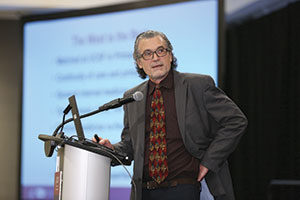
Eliseo J. Pérez-Stable, MD: ‘Race and ethnic minorities share social disadvantages and are subject to health discrimination. That is a legacy that does not get legislated away.’
A former refugee who fled Cuba as Fidel Castro took power is now leading the drive of the National Institutes of Health to grow minority trainee development and the study of conditions that affect minorities of various backgrounds.
Eliseo J. Pérez-Stable, MD, recalled his life Sunday as the keynote speaker at the ATS 2017 Diversity Forum. Dr. Pérez-Stable is the director of the National Institute on Minority Health and Health Disparities, which is part of the NIH.
As an eight-year-old refugee, Dr. Pérez-Stable overcame his “immigration stress” while growing up in Pittsburgh, eventually becoming chief of the Division of General Internal Medicine at the University of California, San Francisco. At USCF, he conducted research on tuberculosis as the HIV epidemic was growing.
“Clinical medicine rediscovered public health during the HIV epidemic,” Dr. Pérez-Stable says, because it was an infectious disease that clinicians could not treat. “My UCSF career was very fulfilling, but I came to the NIH to have an influence on a national level.”
He became NIMH director in 2010 and oversees a $289 million budget. As director, his main goals are to understand the health challenges of minority racial and ethnic groups and to develop mechanisms to reduce disparities in health care for those groups.
“I am interested in minority health, whether the outcomes are good or bad,” Dr. Pérez-Stable says. “Race and ethnic minorities share social disadvantages and are subject to health discrimination. That is a legacy that does not get legislated away.”
The NIMH also looks at other groups that suffer from health disparities, such as the poor, white population and those living in rural areas. Most health care research on those groups, as well as ethnic minorities, focuses on behaviors, but Dr. Pérez-Stable says he wants more focus on studying the biology of those groups.
Dr. Pérez-Stable encourages greater research in several areas, including immigrant populations, disparities in surgical care and outcomes, social epigenomics, sleep disparities other than sleep apnea, chronic liver disease, liver cancer, research with Tribal Epidemiology Centers, and systems modeling and big data.
Other areas of interest he wants the NIMH to study include:
- How various cultures from Latin America, Europe, indigenous populations, and Africa have unified in the United States.
- Cotinine measures in Mexican-Americans, who often are light smokers. That knowledge could lead to new understandings of addiction in smoking.
- Why some groups, such as African-Americans, have higher intakes of nicotine while other groups, such as the Chinese, have lower intakes.
- To carry out this research, Dr. Pérez-Stable, wants to see more minority students go to medical schools.
“The pipeline is not as empty as it used to be,” he says, but points out that only about 12 percent of medical students are minority-group members, even though minorities make up about 40 percent of the U.S. population. “We have a big gap.”
